|
|
|
Sort Order |
|
|
|
Items / Page
|
|
|
|
|
|
|
| Srl | Item |
| 1 |
ID:
140762
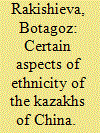

|
|
|
|
|
| Summary/Abstract |
There are about 5 million Kazakhs living all over the world outside the Republic of Kazakhstan, the largest part of them predictably found in the Xinjiang-Uyghur Autonomous Region of the PRC bordering on Kazakhstan
|
|
|
|
|
|
|
|
|
|
|
|
|
|
|
|
| 2 |
ID:
137529
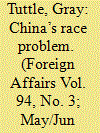

|
|
|
|
|
| Summary/Abstract |
For all the tremendous change China has experienced in recent decades—phenomenal economic growth, improved living standards, and an ascent to great-power status—the country has made little progress when it comes to the treatment of its ethnic minorities, most of whom live in China’s sparsely populated frontier regions. This is by no means a new problem. Indeed, one of those regions, Tibet, represents one of the “three Ts”—taboo topics that the Chinese government has long forbidden its citizens to discuss openly. (The other two are Taiwan and the Tiananmen Square uprising of 1989.)
|
|
|
|
|
|
|
|
|
|
|
|
|
|
|
|
| 3 |
ID:
126043
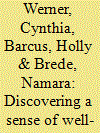

|
|
|
|
|
| Publication |
2013.
|
| Summary/Abstract |
Throughout Central Asia, the end of communism has been marked by a significant change in the management and influence of local mosques. In many rural areas, small underground mosques operated by informally trained, elderly moldas have been supplanted by newly constructed mosques led by younger, foreign-educated local imams and financed by governmental and private donations from Turkey, Saudi Arabia, and other countries. From several perspectives, this 'revival' of Islam is characterized in a way that implies that increased religiosity and piety is somewhat problematic. In this essay, based on six months of ethnographic fieldwork in Western Mongolia, we argue that such an approach prevents an understanding of how religious changes are enhancing the social and material well-being of certain actors. We explore the utility of the concept of well-being by focusing on the everyday lives of Kazakh imams in Western Mongolia. Approximately 100,000 ethnic Kazakhs live in the Western Mongolian province of Bayan-Ölgii, where they comprise about 80% of the population. Although a significant portion of the population has been migrating to Kazakhstan in the post-socialist period, the Kazakhs who choose to remain in Mongolia have experienced a significant increase in religious freedom. In this context, the new cohort of imams is playing an important mediating role as members of the local population reinterpret and renegotiate their identity as Muslims. In addition to finding spiritual well-being through their knowledge of Islam, these imams are acquiring social status and economic security from their local roles as religious leaders and through their transnational connections with a broader Muslim community.
|
|
|
|
|
|
|
|
|
|
|
|
|
|
|
|
| 4 |
ID:
192969
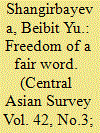

|
|
|
|
|
| Summary/Abstract |
This article examines the roots of freedom of expression and opinion, of the right to a fair trial, and of the freedom to enjoy cultural rights in Kazakh nomadic customary traditions that underlie and give meaning to human rights discourse in contemporary Kazakh society. Based on oral traditions and the perception of fairness of the nomadic Kazakhs, this rich heritage created resilient instruments that are still vital and play a significant role in the judiciary, political discussions, public debates and cultural performances in contemporary Kazakhstan. The evidence indicates that in Kazakh nomadic society a core essence of these freedoms was ‘the freedom of a fair word’, which, combined with outstanding rhetorical skills, functioned as an instrument through which civil, political and cultural rights were ensured; the concept enacted a discourse of commentary and claims-making analogous to norms of human rights. This research provides evidence for how ‘the freedom of a fair word’ was articulated by the general population in the traditional nomadic institutions of the bi, and of the zhyraus and aqyns.
|
|
|
|
|
|
|
|
|
|
|
|
|
|
|
|
| 5 |
ID:
097811
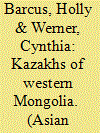

|
|
|
|
|
| Publication |
2010.
|
| Summary/Abstract |
The Kazakhs are the largest minority group in Mongolia, a relatively homogenous country dominated by Khalkh Mongols. Since 1991, Mongolia has transitioned politically and economically and witnessed significant changes in internal and international migration flows. The large-scale movement of ethnic Kazakhs from Western Mongolia to Kazakhstan represents one such emerging international flow. This migration is influenced by economic motivations, historical cultural ties to Kazakhstan, and immigration policies of both countries. This paper assesses the local and national circumstances that shape migration decision-making in Western Mongolia during the transition years and highlights changes in the characteristics and directions of migration flows during this time. We identify three periods of migration with each period characterized by changing economies and national policies in Mongolia and Kazakhstan, as well as changes in communications technologies and extensiveness of social networks among prospective migrants. These periods illustrate how transnational migration flows evolve through time and are affected by national, local, and individual circumstances.
|
|
|
|
|
|
|
|
|
|
|
|
|
|
|
|
| 6 |
ID:
140446
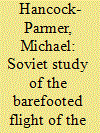

|
|
|
|
|
| Summary/Abstract |
The defeat, devastation and exile of the Kazakhs in the early eighteenth century, commonly known as the Barefooted Flight, was the nation's most distressing pre-Soviet calamity. Kazakh nation-building and official remembrance projects – commemorated in state ceremonies, public education and popular culture – portray an uninterrupted, centuries-old practice of tribute to local heroes who challenged the foreign aggressors. Twentieth-century Kazakh and Russian intellectuals in the Soviet and post-Soviet eras studied and enshrined these events based on published, secondary sources, rarely giving attention to the thin trail of documents preserved in state archives. The historiography of the Barefooted Flight exposed a trend in how politically convenient historical lessons shaped the interpretation of events. By the end of the Soviet Union, some archival material was introduced, it was but misquoted so as not to challenge the current interpretation.
|
|
|
|
|
|
|
|
|
|
|
|
|
|
|
|
| 7 |
ID:
190952


|
|
|
|
|
| Summary/Abstract |
A variety of wormwood, Artemisia cina, once grew abundantly in the Syr-Darya province of Russian Turkestan. Santonin, a drug derived from it, was in high demand. Flowers harvested by Kazakhs were handed over to intermediaries to be processed in Europe, but from the 1880s entrepreneurs from different parts of the Russian empire established their own chemical plants in Chimkent and Tashkent. They pressured the Russian imperial government to restrict the rights of the Kazakhs on land where Artemisia cina grew, and grant them the exclusive right to exploit this resource. These entrepreneurs used conservationist arguments and advocated a ‘cultured’ approach to the management of natural resources located on supposedly ‘State land’. These attempts collided with the usage rights of the Kazakhs, as defined by Turkestan’s governing Statute. By shifting the argument to the political, rather than legal, level, the industrialists eventually gained a monopoly to the exclusion of local entrepreneurs and even assumed State-like functions. This article reconstructs this controversy and allows a glimpse into the evolving claims to natural resources in the ‘periphery’ by both Tsarist colonial power and the Kazakhs themselves. The article also explores the features of autochthonous and Russian entrepreneurship and situates Turkestan in a web of trade connections to the global pharmaceutical industry.
|
|
|
|
|
|
|
|
|
|
|
|
|
|
|
|
|
|
|
|
|